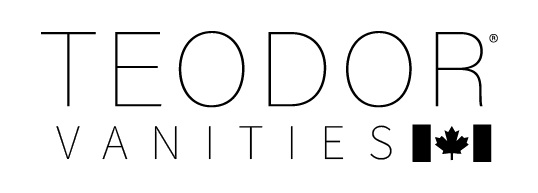CABINET FINISHES
Choosing the finish for your vanity can be a daunting task. With so many choices all varying in cost, style, look and feel, it's easy to become overwhelmed by the decision. The four most common applications used on commerical vanities are lacquer, veneer, melamine, and thermofoil. In this section, we will break down the different finishes to give you a better idea of which product is right for your home.
LACQUER
Lacquers can be broken down into three basic subgroups; nitrocellulose, CAB-Acrylic, and catalyzed lacquers.
Nitrocellulose is your everyday lacquer, it is available in every hardware store, and for the most part produces a great finish. It does tend to break down over time however, giving off a yellow tinge, and with most woods in construction being light coloured this can be a problem.
CAB-Acrylic lacquers are a step up and are made with resins to produce a 'water white' finish, meaning they will not yellow like the nitrocellulose.
Catalyzed lacquers come in both pre- and post-catalyzed products but the result is much the same. Normally lacquers cure via evaporation, however with the added catalyst, they also cure chemically creating an incredibly strong finish that is very durable. In addition to this it keeps the 'water white' finish that prevents discolouration and reduces off-gassing effects. This is the type of lacquer most used in the commerical industry.
A lacquer finish, specifically catalyzed lacquer, has a curing process that is much stronger than more traditional products. As well as being faster drying, this product eliminates some of the few flaws that a traditional lacquer has such as blushing, and off-gassing. On top of that, it is a very durable finish that can hold up against your day to day wear and tear. A great product at a great price makes this finish one of the most popular in the industry.
WOOD VENEER
Veneer is wood cut into sheets from large logs of wood and then wrapped and glued to a core panel, usually of a cheaper solid wood or a plywood. This method is a way of showing off a particular type of wood with all its grain and colour, while maintaining affordability. By using this method, manufacturers, and to some extent consumers, are able to get the absolute most out of an expensive piece of lumber. To get a solid piece of wood is extremely expensive, and most of it is hidden. The strength of the veneer combined with the adhesive, aids in mitigating warping in the wood. Additionally, this process makes the piece stronger than if it were one solid piece. Efficient use of lumber combined with modern adhesives provide us with all the breathtaking beauty of a rare piece of wood, with none of the flaws.
Once applied, usually a thin coat of clear lacquer or stain is used on the product, protecting it from the wear and tear of household use. A clear finish is used to allow the beautiful grain and colour of the wood to shine through.
Wood veneer is the more expensive option of the finishes, however its incredible real look, combined with its durability is more than a fair trade. It looks real because it is real, and with new technology it is stronger than solid wood, giving you all the upside and none of the downside. With many different options of wood to choose from there is also a great versatility to the product. All in all, this is a great option.
MELAMINE
Melamine is a type of laminate. It is an organic compound which, when combined with formaldehyde, creates a durable thermosetting plastic. This material is then used to cover a base of wood or plywood. Much like veneer, it is used to cover a more cost-effective product like plywood or MDF to provide a hard, durable and beautiful finish. This product is also more-light-weight and is more reasonably priced than most finishes. The plastic finish makes melamine scratch and shatter resistant and allows for a vast amount of variation in look and colour.
Due to the way it is created, melamine is an extremely versatile product. it is durable, cost-effective, comes in a wide variety of colours and styles, and is water resistant. Melamine is a very common material when it comes to cabinetry and is lauded as one of the best cost to quality products. A great choice for any bathroom vanity.
THERMOFOIL
Thermofoil is a plastic surface finish that is primarily adhered to an underlying engineered wood core such as MDF. The process in which it is applied is called thermoforming. In this process, a thin sheet or film of plastic is heated to a point where is can be molded around an existing shape or object, in this case, vanity doors, drawers and body.This protective layer usually has a high-quality sheen and, like melamine, is very versatile in its looks. A smooth lacquer look or a faux wood grain, even a metallic looking finish are all styles that thermofoil can imitate. Its plastic coating makes it water resistant and resistant to the average wear and tear of any household.
Thermofoil, while very reasonable in price does have some minor drawbacks. It doesn't hold up very well to a lot of heat, therefore heat shields to separate the product from a heat source are advised. If the thermofoil fails, moisture can seep into the MDF and ruin the cabinet. However, this finish is quite water-resistant and most appliances with enough heat to damage the finish come with heat shields anyway. Thermofoil, like melamine, is quite flexible when it comes to looks and colours so it can cater nicely to your needs as well as your wallet. For doing things on a budget, this is a good finish for you.




